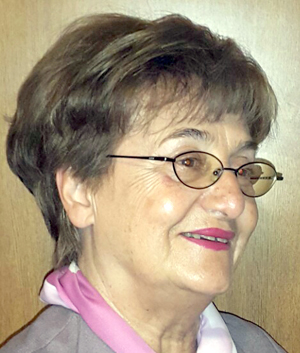From the forest towards the sea, from darkness to light
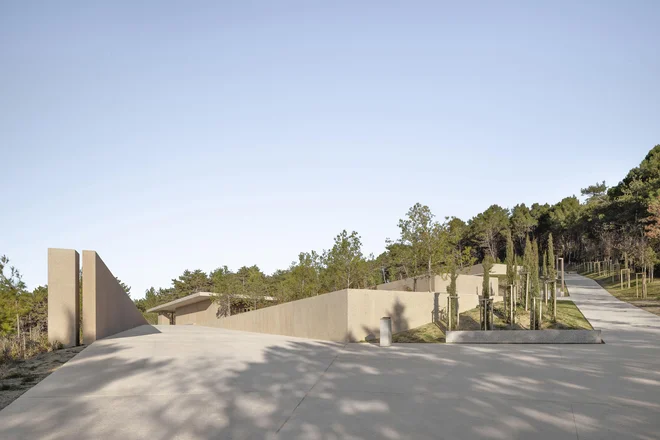
“It is very difficult to change the rooted attitude towards death and thus to cemeteries. We have some extremely well -designed examples that tried to overcome a stereotypical performance and appear to be a new model of a grassy or wooded cemetery, such as the Stara Gora Cemetery near Nova Gorica, Dobrava in Maribor and Srebrnice near Novo mesto, in which nature assumes the main pietal function, « emphasizes landscape architect and professor Thewho co -designed the new Ankaran Cemetery with colleagues from the AKKA studio and architects from the Void Bureau. One more special.
A new cemetery over Ankaran in the immediate vicinity of the church from the 80s. The year of age is the municipality, their most important and largest project so far, but its construction was also one of the most expected, as they have been waiting for more than two decades. It was already placed on the location with the spatial plan of the Municipality of Koper, and construction has already begun, which was stopped due to the changed interests of the then municipality, the area was intended for tourism and sold to a private individual.
“Between 2012 and 2014, the latter reworked the facility and changed its destination into the tourist apartment, but due to the great opposition of the locals, it was never fully completed and did not come to life. Eight years ago, the municipality re -acquired the property and began procedures for adopting a new municipal spatial plan and for the arrangement of the cemetery, and the broadest public was always included in the processes of design and preparation, « summarizes complications in the Ankaran municipality.
This cemetery should look like a landscape, not architecture, the designer Ana Kucan is convinced. Photo: Ana Skobe
In 2019, they announced a public competition for the placement of the intersection of pietet, sacral and recreational activities in the edge of the Ankaran, which included the design of the cemetery with a farewell facility and a bell tower, arrangement of open spaces near the church, the design of a park forest, connections in the area and connections to the surrounding area, including the design of the background and road access to the area.
A key feature of this cemetery is, as the competition committee stressed, that with the inseparable interplay of landscape and architectural design on key elements, such as orientation, materiality and symbolic expression, it acts as a uniform whole with an in -depth contextual narrative. This cemetery is the newly created landscape of the highest, symbolic value and special cultural importance in the otherwise extensive cultural landscape of the Ankaran hinterland, the co -author of the design, Ana Kucan, is convinced.
It is purposefully equally consisting of built horizontal and tree verticals, built and green surfaces, into an expressively strong space at the passage between the theme and the density of the forest and the boundless openness of the sea horizon. The red thread is the organization of a slope space that rests on the central ritual path. The derivation of this path ran along with the transformation of relief into five terraces that lay down the slope. The ritual route, which begins on the square in front of the cemetery, leads through a farewell facility and is serpentinally poured between the terraces on which the grave fields are erected.
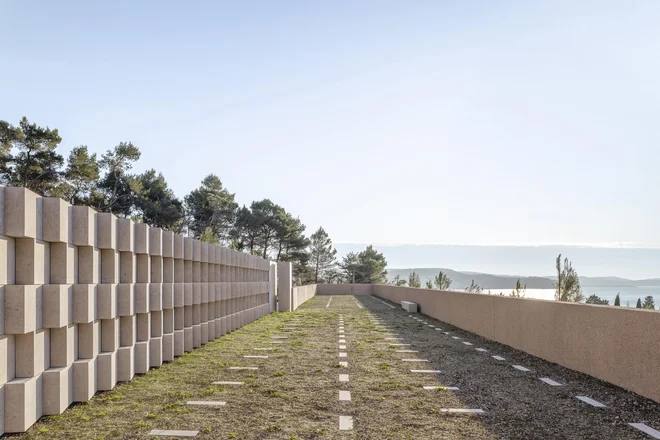
The hardest question was how to combine the modern model of the cemetery with traditional, but because of the restrictions of the space, the idea of fencing only grave fields was fenced off, thus reinterpreting the traditional walled cemeteries. Photo: Ana Skobe
“Therefore, the visitor experiences the cemetery space sequential, in exchanging the directions of walking and the views of the forest thicket and the openness of the horizon, while walking between the grave fields and entering the grave fields alternately experiences the plant from forest to the sea, from darkness to light. The views are directed by the walls, framed by pines. This spatial dramaturgy also constantly embeds the visitor in a wider spatial context, « explains the interviewee.
Response to the outburst of death from an individual’s consciousness
The hardest question, according to her, was how to combine the modern model of the cemetery with the traditional, but because of the restrictions of the space, the idea of fencing only the grave fields, which reinterpreted the traditional walled cemeteries, provided the manageable size of grave fields, while opening the cemetery into the everyday life of the place, summarizing.
The cemetery, which opens to the sea, to Izola, Koper, Piran, to the entire Gulf of Trieste all the way to Gradež and the Dolomites, were sought to be designed as a public park, as a place of reputation, memory, contemplation, which is not separated from the life of the place. With the involvement of the cemetery in the public route system, they responded to the removal of deaths from the consciousness of the individual and the community and set the possibility that the cemetery acts as a community space, to transform as part of a free transitional forest on the edge of a heterotopia settlement into a metaphor of the community.
« At the same time, we sought to set a new model in terms of more sustainable regulation of purely practical aspects of cemetery infrastructure, as well as by consciously abandoning imported rocks, plastic tombstones and flowers, » he says. Therefore, they suggested that tombstones be unified in material, Karst limestone, which is the material of traditional Mediterranean cemeteries.
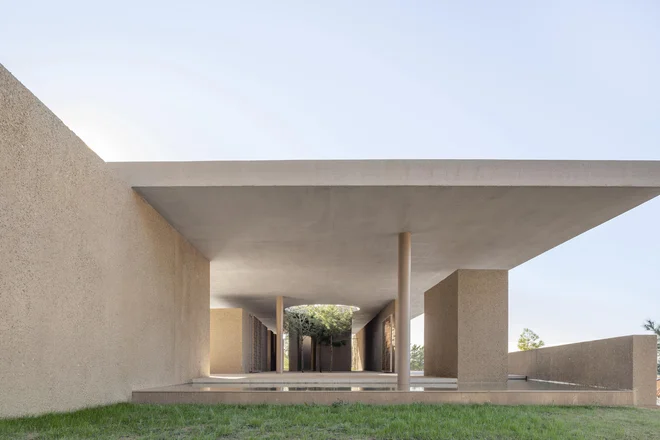
For the supporting walls of the farewell building, prana concrete in the earth’s fleece was defined, and for more important ones, such as the plate under which it enters the cemetery or grilled walls, a sanded concrete. Photo: Ana Skobe
However, the design of the modern or more sustainable concept of the cemetery made it difficult to slope from the flysch base, which is prone to crawl, ensuring the manageable slopes of the ritual path and banks between the terraces, the consideration of parcel boundaries and the area of treatment. It was also necessary to take care of enough shadows, and from all these restrictions and the requirements, the authors gave birth to the decision not to enclose the cemeteries, but to be placed in a network of public paths, and with the wall only bounded by individual graves on the terraces.
“This also gave us enough possibilities for planting trees that will form a hovering, illuminated vault with their canopy, and with the verticals of the thick, frame the views, contributing to the construction of the space and connected to the topographic context, as we could return the forest to the area. Such a cemetery, with its design, sincerely shows its double nature. On the one hand, it is part of a freely transitional forest intended for walks and recreation, and on the other, a series of reduced grave fields that are ripened above the farewell facility in the terraces. The completely pragmatic aspects of the design, however, are inextricably intertwined with symbolic ones, « Kucanova further explains.
They tried to design the cemetery as a public park, as a place of reputation, memory, contemplation, which is not separate from the life of the place but acts as a community space.
Also the space of individual mourning
Architect Uroš Rustja – At his first visit, he was impressed by the location with wonderful views of the sea, so it seems particularly important that this remained public space – he emphasizes that, in addition to the public point of view, the parking forest, the sea views, the second aspect must be taken into account.
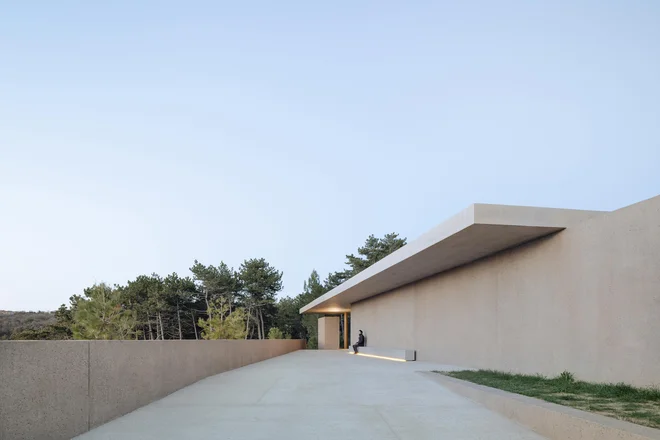
It is also a place of individual saying goodbye, mourning, memory, contemplation. Photo: Ana Skobe
“That this must also be a place of individual repositioning, mourning, memory, contemplation. The double design of this space, on the one hand, manifests itself as openness, and on the other as introvert and enabling memory and reputation in contemplative. But in this cemetery you will be looking for stereotypical symbols in vain, instead of them full of different atmospheres that originate from both the cemetery program and the natural, very typical Mediterranean context, « he says. The materiality of new placements was also drawn from this context.
Due to all the interventions, all the wounds described by the interlocutor, which had been experienced by this location before their arrangement, the characteristic of Slovenian Istria – Fleis, who took it as the lead element, has clearly shown here. For the supporting walls of a farewell facility, which are anchored in the field and geometrizing it, they defined the prana concrete in earth colors of fleece, and for all other, more important, noble elements, such as, for example, the plate under which it enters the cemetery or grilled walls have been determined by a brushed concrete.
The interior of the farewell building is also made of brushed concrete, according to Uroš Rustja, also an assistant professor at the Faculty of Architecture in Ljubljana, so the treated concrete surface is completely different. In contrast to the washed concrete, characterized by pronounced shadows, the brushed concrete surface diffuses the light and therefore creates a very diffuse lit space, which gives it a sacral, contemplative dimension.
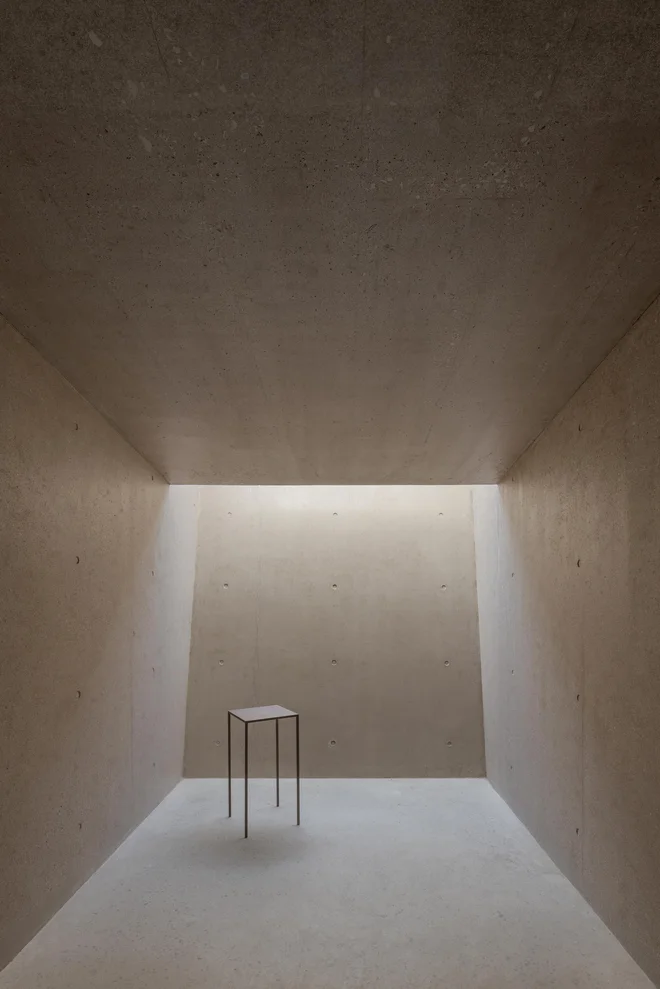
The interior of the farewell object is made of brushed concrete, since the treated concrete surface thus shapes light differently. Photo: Ana Skobe
“Since light is an important element in this space, the furniture was trying to create as lean as possible, invisible, so it is metallic that light can enter this place as much as possible. By painting in earth shades, it also connects with all the textures of the area, flysch stone, earth, trunks of pine trees, « says the interplay of natural and certain moves of the area.
The ritual route is made of bright, stubbled concrete and is raised above the terrain, so it is blinking above the hooded banks. Individual highlights, both glow wall panels and floor graves are from local karst limestone, and all that users touch, such as doors on the door, is made of oak wood. All this was created and made up very gradually, through the design process, he adds.
The new Ankaran cemetery includes a farewell facility, three grave fields with a total of 536 graves (110 classic graves, 246 floor graves and 180 wall graves) and a field for ash spread.
To re -invent the typology of the cemetery
According to him, we may not even be aware that in recent decades our perception of transience has changed a lot, he is convinced that we have to re -invent the typology of the cemetery, just like the typology of other aspects of our existence; Even the modern library is no longer as it was in the 60s or 70, but a completely different space.
“Today, grilling burials dominate, and a modern cemetery is becoming part of life, a public space connected to the community, which is also clearly manifested in Ankaransky. When we visit it, we are pleased how many people walk through and along the paths to which it is connected, « Rustja states. A connecting footpath with a settlement on the north side of the cemetery is expected to be completed next year.
Otherwise, the design of the cemetery is different from all other projects, especially in that it can be liberated by all the technologies that is needed, or today as users, we demand in all other programs. Thus, at the premises of reputation and memory, the atmosphere and architectural rumor are easier to express, although the interlocutor emphasizes that, among other things, large underground tanks of meteor water have been arranged in the described, intended for watering and maintaining green spaces.
Ankaran
Subscription: The municipality of Ankaran
Construction Year: 2024
Authors: Uroš Rustja, Primož Žitnik, Mina Hiršman, Mateo Zonta (Void, Architecture) and Ana Kučan, Luka Javornik, Danijel Mohorič (Studio Akka, Landscape Architecture)
Collaborators: Tomaž Mlinarič (Reading Graphics)
Gross surface: 7085 m2
Investment value: The value of construction, craft and installation works for both public procurement was € 3.533 million (excluding VAT)

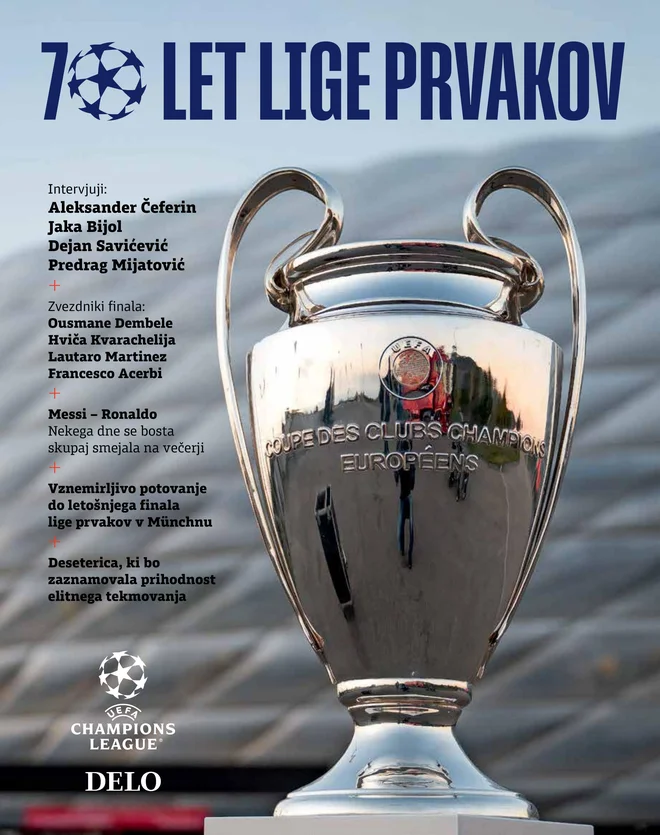



/s3/static.nrc.nl/images/gn4/stripped/data132852687-3c5e5d.jpg)
